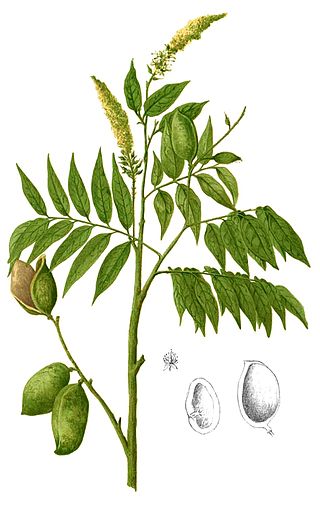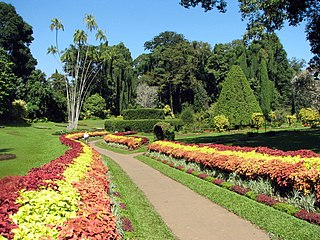
The Western Province is one of the nine provinces of Sri Lanka, the first level administrative division of the country. The provinces have existed since the 19th century but did not have any legal status until 1987 when the 13th Amendment to the Constitution of Sri Lanka established provincial councils. Western Province is the most densely populated province in the country and is home to the legislative capital Sri Jayawardenepura Kotte as well as to Colombo, the nation's administrative and business center.

The Crypteroniaceae are a family of flowering trees and shrubs. The family includes 13 species in three genera, native to Indomalaya.

Couroupita guianensis, known by a variety of common names including cannonball tree, is a deciduous tree in the flowering plant family Lecythidaceae. It is native to the tropical forests of Central and South America, and it is cultivated in many other tropical areas throughout the world because of its beautiful, fragrant flowers and large, interesting fruits. Fruits are brownish grey. There are potential medicinal uses for many parts of Couroupita guianensis, and the tree has cultural and religious significance in India. In Sri Lanka, the cannonball tree has been widely misidentified as Sal, after its introduction to the island by the British in 1881, and has been included as a common item in Buddhist temples as a result.

Gampaha is an urban city in Gampaha District, Western Province, Sri Lanka. It is situated to the north-east of the capital Colombo. It is the sixth largest urban area in Western Province, after Colombo, Negombo, Kalutara, Panadura and Avissawella. Gampaha is also the second largest municipal centre in Gampaha district, after Negombo. Gampaha has a land area of 25.8 ha and is home to the offices of 75 government institutions.

Crudia is a genus of plants in the family Fabaceae.

Pericopsis mooniana, the nandu wood or nedun tree, is a species of legume in the family Fabaceae. It is found in Indonesia, Malaysia, Micronesia, Palau, Papua New Guinea, the Philippines, and Sri Lanka. It is threatened by habitat loss.

Adenomus kandianus is a species of toad in the family Bufonidae endemic to Sri Lanka. It is a high-altitude species known only from few localities. The specific name kandianus means "from Kandy" and seems to suggest that the type material came from near the city of Kandy.

Mangifera zeylanica or "Sri Lanka wild mango" is a wild species of mango tree endemic to Sri Lanka. This stately tree is the tallest member of the mango genus, Mangifera, and one of the two tallest trees in the family Anacardiaceae. The mango fruits are edible and have an excellent taste. It is called "aetamba" (ඇටඹ) or "wal amba" in Sinhala and “kaddu-ma” in Tamil. The well-known British botanist and explorer Joseph Dalton Hooker first described the tree in 1876.
Sauropus assimilis is an extremely rare species of plant in the family Phyllanthaceae. It is a tree growing in wet evergreen forests in lowlands. Endemic to southwestern Sri Lanka, and only known from the Sinharaja Biosphere Reserve there, evidence of its existence was last catalogued before 1991, and it has not been found since then. It may since have become extinct.

Royal Botanic Gardens, Peradeniya are about 5.5 km to the west of the city of Kandy in the Central Province of Sri Lanka. In 2016, the garden was visited by 1.2 million locals and 400,000 foreign visitors. It is near the Mahaweli River. It is renowned for its collection of orchids. The garden includes more than 4000 species of plants, including orchids, spices, medicinal plants and palm trees. Attached to it is the "National Herbarium of Sri Lanka". The total area of the botanical garden is 147 acres (0.59 km2), at 460 meters above sea level, and with a 200-day annual rainfall. It is managed by the Department of national botanic gardens.

Lakshman Bandara Kiriella, MP is a Sri Lankan politician and lawyer. He is a Member of Parliament from the Kandy District, former Leader of the House of the parliament. Also he held office as Minister of Public Enterprises and Kandy Development and as Minister of Higher Education and Highways from 2015 to 2019.

Udawattakele Forest Reserve often spelled as Udawatta Kele, is a historic forest reserve on a hill-ridge in the city of Kandy. It is 104 hectares large. During the days of the Kandyan kingdom, Udawattakele was known as "Uda Wasala Watta" in Sinhalese meaning "the garden above the royal palace". The sanctuary is famous for its extensive avifauna. The reserve also contains a great variety of plant species, especially lianas, shrubs and small trees. There are several giant lianas. Many of small and medium size mammals that inhabit Sri Lanka can be seen here. Several kinds of snakes and other reptiles might be seen. Udawattakele was designated as a forest reserve in 1856, and it became a sanctuary in 1938.
Hunteria zeylanica grows as either an evergreen shrub or as a tree up to 15 metres (49 ft) tall, with a trunk diameter of up to 34.5 centimetres (13.6 in). Its flowers feature a white corolla. The berries are yellow. Its habitat is forests from sea level to 350 metres (1,150 ft) altitude. The trees can withstand salinity. Local medicinal uses include for stomach-ache. Hunteria zeylanica wood is used for weapon handles and as firewood. In Africa, the plant is native to Kenya and Tanzania and in Asia it is native to China, India, Sri Lanka, Indochina and western Malesia.

Henarathgoda Botanical Garden, also known as Gampaha Botanical Garden, is one of the six botanical gardens in Sri Lanka. The botanical garden is situated on the Gampaha-Minuwangoda main road, approximately 450 m (1,480 ft) away from Gampaha railway station. It is about 29 km (18 mi) from Sri Lanka's commercial capital of Colombo.

Dysoxylum championii is a tree in the Meliaceae family. It is endemic to Sri Lanka.
Dichilanthe zeylanica is a species of flowering plant in the family Rubiaceae. It is endemic to Sri Lanka. It is a tree that grows in evergreen forest habitat.

The Central Expressway (E04), is an under construction road project that will link the Sri Lankan capital, Colombo, with Dambulla & Kandy. It will provide a fast alternative to the existing A1 Colombo - Kandy & A6 Ambepussa - Trincomalee Highways. The Expressway starts at the Kadawatha Interchange on the E02 Outer Circular Expressway and ends in Dambulla at the A9 Kandy - Jaffna Highway, traversing through Gampaha, Kurunegala & Matale Districts. A link Expressway starting from Pothuhera & ending in Galagedara will provide access to the Kandy District.
Gastrodia zeylanica is a species of potato orchids which is endemic to Sri Lanka. It was added to the 2007 Red list of Threatened Fauna and Flora of Sri Lanka as 'critically endangered', on the basis of it having only been collected from a few localities.
The following lists notable events that took place during the year 2021 in Sri Lanka.

Rubber production in Sri Lanka commenced in 1876, with the planting of 1,919 rubber seedlings at the Henarathgoda Botanical Gardens in Gampaha. The total extent under rubber in 1890 was around 50 ha and in the early 1900s it increased to around 10,000 ha. By 1982 the total extent under rubber was around 180,000 ha and the total annual production was 125,000,000 kg (276,000,000 lb). However, the total extent under rubber declined subsequently and at present it is around 120,000 h (430,000 ks)a. Rubber contributes about 0.6% of the total GDP. According to figures published in 2018 by the Rubber Research Institute of Sri Lanka, producing 82,600,000 kg (182,100,000 lb) in 2018.















